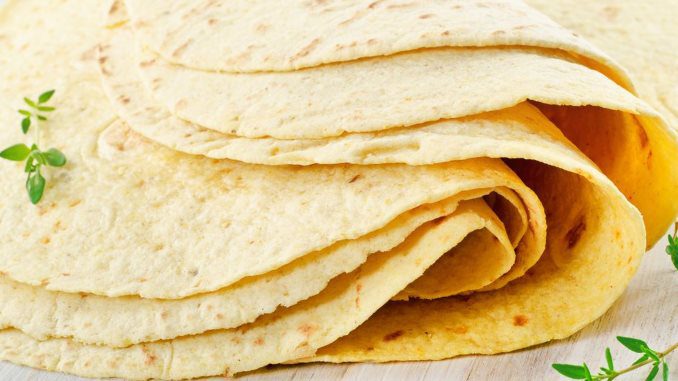Tortilla or bread? Which one is better?
Frankly, the differences between tortillas and bread aren’t tricky to spot visually and functionally. These two staples appear distinctively, and people use them in different situations (the former usually appears in Mexican or Tex-Mex cuisine only). However, there is more to add to the tortilla vs bread comparison.
So, if you want to know in detail how these two staples differ, keep on reading!
Quick Facts
Tortilla:
- Shape: Thin, flat, circle (sometimes oval or square).
- Ingredients: Corn (or wheat), flour, and water. No rising agent. Seasonings (salt or spices) for extra flavor.
- Batter preparation: No specific order. No resting.
- Size: 2.4 to 24 inches.
- Cooking method: Fry on a griddle or frying pan.
Bread:
- Shape: Many different shapes but usually bloated.
- Ingredients: Any flour, water, and leavening agent (milk, butter, eggs, sugar, salt, and oil are usually necessary)
- Batter preparation: Ingredients’ order is a must. Resting time required.
- Size: Different sizes.
- Cooking method: Bake in an oven.
Related: Top 30 Mexican dishes ranked
Tortilla vs Bread – The Difference
Ingredients
Do you know that one crucial difference between a tortilla and bread is their main ingredients?
There are only 2 kinds of tortillas nowadays: corn-based and flour-based ones. While people use hominy, a kind of alkali-processed corn starch, to make corn wrappers, wheat flour is the main ingredient.
Wheat wrappers are considerably more straightforward to make than a bread since they involve flour plus water. A few people also prefer to add some spices to this flatbread, but this act serves no other purpose except adding taste.
On the other hand, although flour and water are also the main components of bread, this staple calls for a must-have addition – a yeasting agent (for example, baking powder, baking soda, and yeast are some agents that people usually use).
Furthermore, milk, eggs, sugar, salt, butter, and oil are additional components that usually appear on the must-have list of bread ingredients. To make different fusions, you can also add corn, banana, and other fruits.
Batter Production
Another distinction between these 2 staples is their batter, specifically the dough production.
Unlike bread that requires precise timing and components’ adding order, making tortillas means simply mixing wet and dry elements. There’s also no need for the proofing (rising) phase while preparing tortillas since they call for no leavening agent.
However, with breads, everything is different. As it contains rising agents, you should let the dough sit and “rise” until it doubles in size. Again, different resting processes decide the sort of bread you’re preparing.
Shape
Perhaps, the most evident difference between these two is their appearance, notably their shape.
The classic technique to prepare tortillas is to divide the dough into small balls and flatten them with a press or roll. Thus, they usually look flat and round. However, they can also be square or oval, depending on different applications.
Meanwhile, bread-shaping is more challenging. Its serving style is significantly dependent on the size and shape.
A baguette is a classic instance of a long, thin loaf. Sourdough often comes in large oval loaves with a slashed top, although it can also be available in round shapes. A few countries even come up with their fusion braided bread called Challahs.
Size
As for size, tortillas typically range from 2.4 to roughly 24 inches in diameter. This diameter varies according to where it arrives and what the dish is.
For instance, as tacos call for a manageable size for people to enjoy using their hands, tortillas about 6-7 inches in diameter are the go-to choice. Meanwhile, burritos require tortillas that are wide enough to load lots of fillings yet small enough to wrap tightly, making a 10-12 inch wrapper ideal.
On the other hand, bread sizes vary a lot. Typically, its size depends on the style; nevertheless, today, many make smaller or bigger bread variants for different applications.
Cooking Method
Finally, bread or tortilla is also distinguishable when it comes to the cooking method.
Preparing tortillas requires a hot skillet or griddle, which is ideally made of cast iron. When you fry them, make sure they possess a uniform, golden tint before taking them out to serve.
According to the wrapper’s diameter and the skillet’s temperature, frying tortillas takes 10 secs to 1 min per side on average. As soon as you press them and the doughy feeling disappears, they are ready to serve!
There are multiple bread-baking methods nowadays. Most people use an oven, yet sometimes an open fire, a tandoori oven, or a traditional bread oven are the preferred choices.
The differences in baking heat, periods, and method can easily result in different tastes and textures.
Are Tortillas Better for Your Health Than Bread in Terms of Nutrition?
Indeed, they are, in several aspects when talking about nutrition facts. Specifically, tortillas are often lower in calories and carbohydrates compared to bread. Furthermore, because of its smaller and flatter shape, a tortilla’s portion is also much smaller.
Which One Is Healthier: Corn Or Wheat Tortillas?
You should know that corn wrappers are a better choice for your health than wheat ones. Why it’s a healthy choice? This is because wheat flatbreads and flour loaves do not offer as many nutritional values as corn ones.
In addition to being low in carbohydrates and calories, they are also a good source of fiber. And fiber assists in strengthening your digestive system.
And homemade ones are the best for your health, and using a cast iron tortilla press is the perfect way to make them. This way, you’ll have complete control over whatever gets involved in preparing your tortillas, as well as serving sizes.
How Many Calories Are There in a Piece of Corn or Flour Tortilla?
The answer is around 62 calories for a corn tortilla and 85 calories for a flour tortilla.

